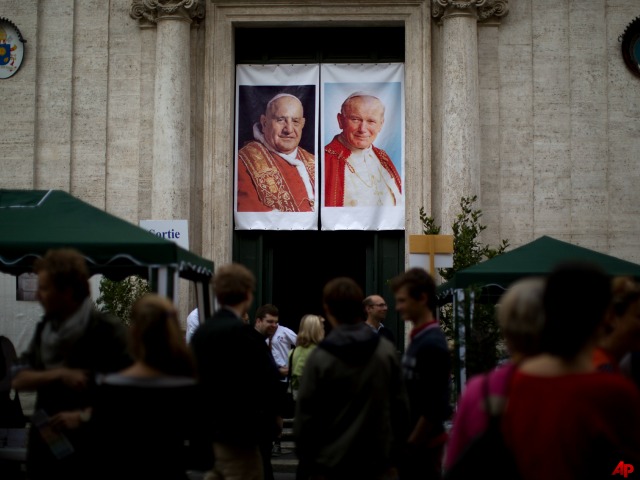(AFP) — Pilgrims and dignitaries from the world over streamed into Rome a day before John Paul II and John XXIII are named saints in the first ever double papal canonisation.
In front of the Vatican Saturday, families and groups of scouts armed with folding chairs and sleeping mats braved skies threatening rain to stake out their places in a swelling queue to get onto St. Peter’s Square, which will only open in the early hours of Sunday.
Poline Tallen from Nigeria, who was dressed in a blue and yellow boubou dress with images of John Paul II’s face on it, said she had travelled for the ceremony because the Polish pope “had a great impact on me. I met him in 1983 here in Rome, and it changed my life.”
Nearby, the leader of a boisterous crowd freshly arrived from Lebanon said “we have nothing with us, just our flags. But we’re happy to be here even if it rains!”
Schoolchildren wearing yellow John Paul II backpacks mingled with nuns lugging suitcases off coaches at Rome’s main Termini train station, where Italy’s civil protection agency had set up a huge medical tent.
Priests strumming guitars and singing Hallelujah had taken to the streets of the city’s historic centre late Friday, while others holding high crosses led prayers amid curious crowds of ice-cream eating tourists.
– Shiny new halos –
Also in Rome for the ceremony were 98 official foreign delegations, including Zimbabwe President Robert Mugabe and Polish Solidarity leader Lech Walesa.
Ukrainian Prime Minister Arseniy Yatsenyuk cut his trip short amid growing fears Russia could be about to invade his country.
Tapestry portraits of the new saints were on show high above the crowd in St. Peter’s Square, while posters in the surrounding streets showed John Paul II and John XXIII already boasting shiny halos, presided over by a benevolently smiling Pope Francis.
The late pontiffs will join the roster of saints at what will be the first-ever double papal canonisation on Sunday, seen as an attempt to unite conservatives and reformists.
Poland’s charismatic, globe-trotting John Paul II became an icon to many conservative Catholics, while Italian John XXIII — nicknamed “Good Pope John” — garnered his liberal reputation by calling the reform-led Second Vatican Council (1962-1965), which breathed new life into the Church.
The canonisation of two of modern-day Catholicism’s most influential figures will be presided over by Pope Francis and attended by his elderly predecessor Benedict XVI, bringing two living pontiffs together to celebrate two deceased predecessors.
Delegations from across the world will join thousands of bishops, priests, and scarlet-cloaked cardinals and the 800,000 or so pilgrims expected, who will be able to follow the ceremonies in different languages on 19 giant screens in some of the Italian capital’s most picturesque spots.
Churches will remain open all night Saturday for prayer vigils ahead of the mass in St Peter’s Square on Sunday to honour two Roman Catholic leaders whose pontificates spanned from the height of the Cold War with the Cuban missile crisis to the fall of the Berlin wall.
The Vatican’s official bureau for pilgrims said 4,000 coaches bearing pilgrims would be arriving in the run-up to the 10:00 am (0800 GMT) mass, along with special trains and boats, while other faithful will watch the canonisation in 3D at cinemas across the world, from Argentina to the United States.
The unparallelled double ceremony has drawn criticism from some who argue the canonisation process was rushed and the pontiffs in question do not deserve the honour.
John XXIII had only been credited with one of the two supposed miracles required for candidates to be declared saints, but Francis approved his canonisation of John XXIII anyway, saying that the late pope was so widely adored that he did not need a second miracle.
And despite fierce accusations against John Paul II that he hushed up child sex crimes that began to come to light during his pontificate, his elevation has been the fastest since the 18th century when the current canonisation rules were installed.

COMMENTS
Please let us know if you're having issues with commenting.